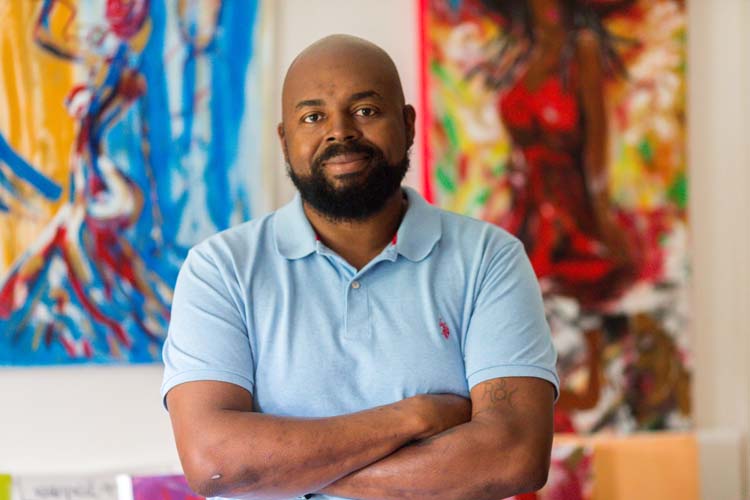
You might think you know Jemal Hayes, owner of Vero Beach-based Mr. J’s Media Productions. For more than 17 years he has worked in graphic design, portrait photography and videography, building a client base that stretches throughout Indian River County. That business is still going strong, but Hayes has a brand new bag too: fine art. That pursuit is not quite a year and a half old, but he has completed “easily 50 paintings” since picking up the brush in early 2017.
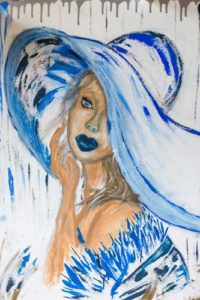
Artist Jemal Hayes
Hayes started by taking a class at the Sebastian Art Club. He thought he had signed up for a portrait class with Judy Burgarella, but it ended up being a palette knife class with Louis Haynes.
“The palette knife kind of stuck with me,” says Hayes.
He now uses brushes in addition to different varieties of paint-applying knives and tools. Working on stretched and primed canvas, he used to begin his compositions with an acrylic underpainting before completing them in oil. Now Hayes works in acrylic paint from start to finish, only occasionally reaching for his tubes of oil.
“Fast forward about a year,” he says with a chuckle. “In January I was a featured up-and-coming artist at Sebastian Riverfront Fine Art and Music Festival.”
An art fair newbie, he hoped one (just one!) of his paintings would sell. Instead, he sold eight.
Not long afterward, he stopped by the Sebastian Art Club.
“I walked in and everybody stands up and applauds. It was embarrassing,” he says, modestly shielding his eyes and grimacing – but his rictus has more pleasure in it than pain.
A native Floridian, Hayes has been a local resident for all of his 43 years. His high school sweetheart, Simmone (née Worrell), was a candy striper at Indian River Memorial Hospital back then; today she is a nurse at Lawnwood Regional. The couple married in 1995 and produced four children, two of whom are still in high school.
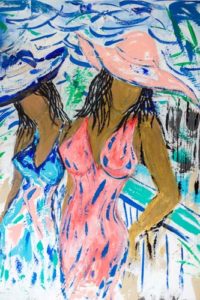
Artist Jemal Hayes
Hayes was still in his 20s when he began his own business. He later added Jemal + Simmone Vero Beach Wedding and Beauty Photography to his services, working on shoots with his wife, whom he cites for her “feminine touch.”
Hayes’ painting studio is located at his home; the front door opens into it. The spacious, cathedral-ceilinged room has an easel at its center, complete with a work in progress. Finished works, as well as those that need a revisit, hang on the walls, while other works and blank canvases lean against them. Ample natural light is provided by two large windows that look out onto the street. An L-shaped seating area and a coffee table bearing books about Picasso and American figural artist Fahamu Pecou complete the atelier.
From many of the works on display, red leaps out at you in all its passionate intensity; the color is as much a subject for Hayes as the female figures he likes to depict. Many of the latter are shown dancing or twirling, their spinning skirts simultaneously created and adorned with well-placed sweeps of brush or palette knife.
A recent painting of a spinning dancer shows a woman stopped in the moment with her back to us and her flounced skirt flashing around her thighs. The perfectly spaced pink and white stripes at the edges of the skirt were applied with a serrated knife; the dancer’s black bodice is laced tight with knife-applied strands of white paint. The painting’s background is an abstract composition of translucent ocher topped with a syncopated rhythm of vertical red, black and white brushstrokes. Amid all that bright activity the woman’s solidly painted back anchors the composition, while adding warm sensuality to it.
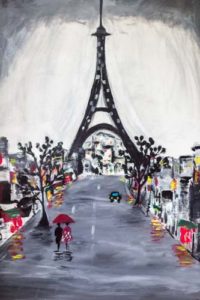
Artist Jemal Hayes
Hayes says that Simmone is his muse when it comes to pictures of dancers.
“My wife likes Latin dancing, and I can’t dance,” he says, shyly adding that he wants to learn.
Hayes has begun to put dancing couples into his pictures, as well as twosomes in equally romantic situations. In one notable work, a pair is shown kissing on a rainy city street, their moment of intimacy shielded by an open red umbrella.
“I find that I like art to try to tell a story, or evoke some type of emotion,” he says.
To draw viewers into the action, Hayes says that painting large work best.
His “favorite” canvas size is 30 x 40 inches; so far, he has painted as large as 36 x 48 inches. It is easy to imagine him going even bigger.
“I just don’t like to paint small,” he says.
Hayes says that to answer the question of why he suddenly jumped into painting with such dedication, he began keeping a journal; writing down his thoughts about painting.
“It might sound like a cliché, but the canvas is a place where I can lose control and not have to feel guilty about it. I can do it and whether someone likes it or not, I really don’t care.”
“I used to draw a lot when I was younger,” he adds, noting that his grandmother, Naomi Wallace, raised him and encouraged his latent talent.
“My grandmother was Mother,” he says.
A generous, good-natured woman, she was the “Mother Goose of the neighborhood,” Hayes says. On weekend evenings when the little kids – including Jemal—were tuckered out from play, they slept four or five to the bed in grandmother’s home while their parents danced and partied.
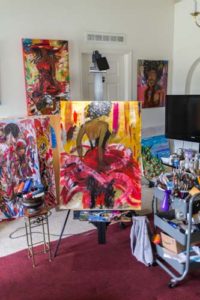
Artist Jemal Hayes
When he grew to be a young man without a clear sense of direction, Hayes’ grandmother prayed for him.
“I honestly believe that was a real turning point in my life. She blessed my hands. After that I pretty much started my career and went on from there,” he says.
Naomi Wallace died in 2011. Partly as a tribute to her, some of Hayes’ paintings have religious themes; among others, a portrait of Jesus and a large Crucifixion that Hayes titled “City of God” for the modern skyline that appears in the background.
Hayes’ grandfather, J.C. Wallace, worked for both the Sexton and Tripson families when Hayes was growing up. It was he who brought 13-year-old Jemal to Sean Sexton’s house for a few painting lessons.
The first thing teacher and student did together was to cut a palette for Hayes out of a piece of board.
Hayes wishes he still had it.
But while the memento is lost, the connection remains.
In April, Hayes had a booth for his artwork at the Hibiscus Festival and Sean Sexton stopped by to say hello.
“Sean talked about me coming out to paint at the ranch,” says Hayes.
“I might take him up on that.”



